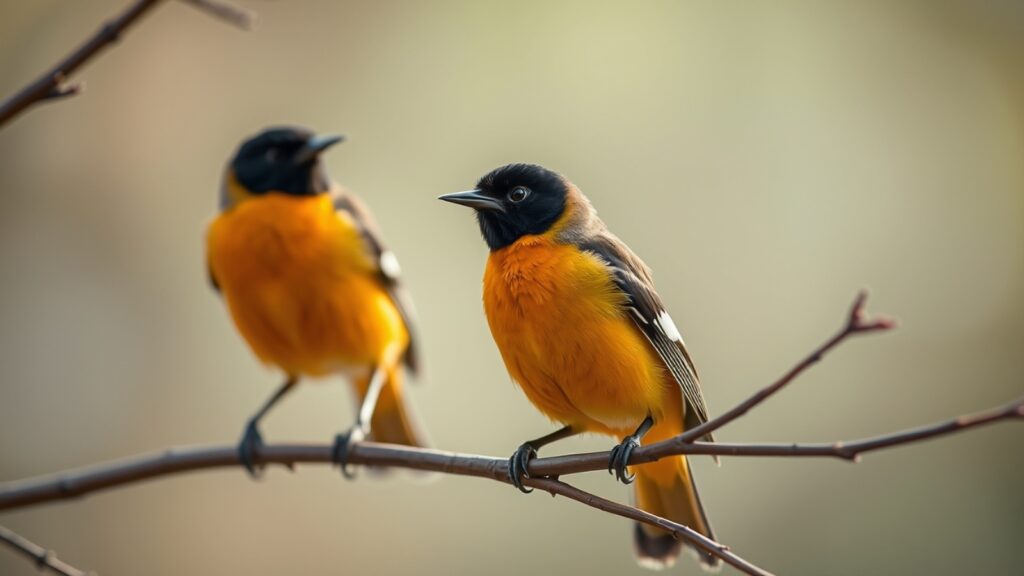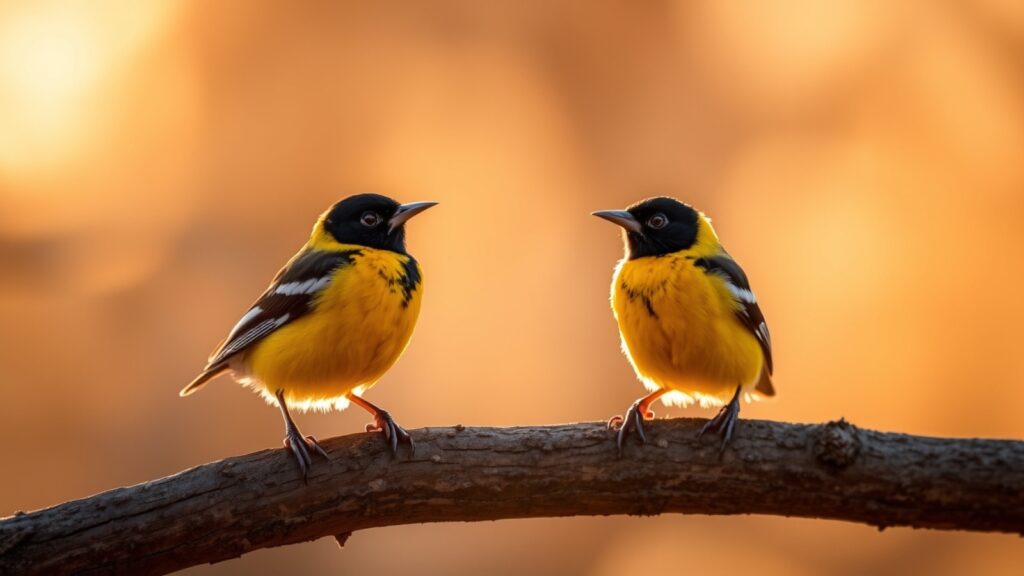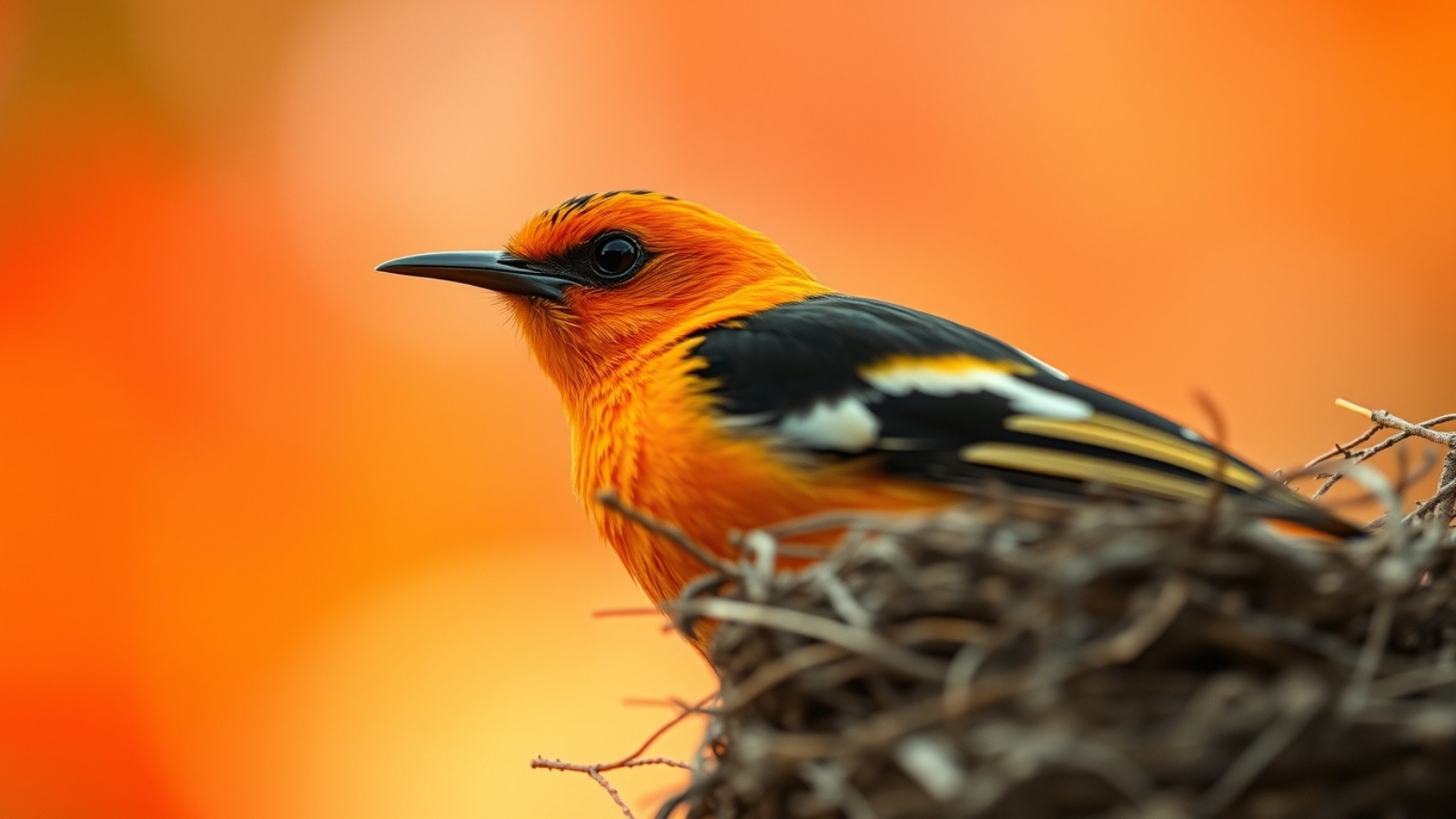When I first discovered how orioles build their nests, I could hardly believe my eyes. These seemingly ordinary birds perform an engineering feat that would challenge even skilled human craftspeople.
Without tools, blueprints, or formal training, orioles create suspended homes that combine artistic beauty with remarkable structural integrity.
Their secret? A masterful combination of instinct, skill, and innovative techniques passed down through generations.
In this article, we’ll uncover the extraordinary methods these avian architects use to construct their hanging homes. What you’ll learn about their building process will transform how you think about bird nests forever.
From their careful material selection to their precise weaving techniques, orioles demonstrate a level of craftsmanship that truly must be seen to be believed.
Key Takeaways
- Female orioles are the primary architects, spending one to two weeks carefully weaving plant fibres into secure, hanging nests.
- The nest’s suspended design protects eggs and chicks from predators while offering resistance to harsh weather.
- Each nest contains hundreds of woven fibres, creating a structure as strong as it is beautiful.
- Young orioles improve their building skills over time, showing how this complex behaviour combines instinct with learned expertise.

Related post: Are Hummingbird and Oriole Feeders the Same?
How Oriole Nests Work
Think of an oriole’s nest as a tiny, hanging house made from natural materials. Just like how we build houses to keep our families safe and comfortable, orioles create their nests with two main goals: protecting their babies and staying safe from bad weather.
The nest looks like a deep pocket or bag that hangs from a tree branch. What makes it special is how it’s built – it’s both strong and flexible at the same time. Imagine holding a basket that’s tightly woven but can still bend without breaking. That’s exactly what an oriole’s nest does.
When wind blows, the nest gently sways back and forth instead of staying stiff. This movement actually helps keep the nest safe, just like tall buildings are designed to sway slightly in strong winds.
The nest’s walls are thick enough to keep baby birds warm when it’s cold and cool when it’s hot, similar to how the walls of our homes help control temperature.
What’s really clever about these nests is where they hang, at the very ends of tree branches. This might seem strange at first, but it’s actually very smart. Most animals that might want to eat the oriole’s eggs or babies (like snakes or squirrels) can’t reach these thin branches without falling.
It’s like building a treehouse at the very tip of a branch where only birds can reach it.
How Female Orioles Build Their Nests
The female oriole takes centre stage in this architectural wonder. For up to two weeks, she works tirelessly to create her suspended nursery. Her only tools? A precise beak and an innate understanding of engineering principles that would impress any human architect.
The male supports her efforts by gathering materials and protecting their territory, but the intricate construction remains solely her domain.
How Orioles Choose Where to Build
Success begins with choosing the right spot. Female orioles carefully assess various branches before making their selection. They look for specific qualities in their chosen location:
- Height: The nest must be high enough to avoid ground predators
- Branch thickness: It should be strong enough to support the nest but thin enough to discourage climbing predators
- Cover: Surrounding foliage must provide adequate protection while allowing easy access
- Tree species: Deciduous trees like elms, maples, and cottonwoods often provide ideal conditions.
What Orioles Use to Build Their Nests
Orioles show remarkable selectiveness in their choice of building materials. They seek out specific natural fibres that offer both strength and flexibility:
- Plant fibres from milkweed and other fibrous plants
- Long grasses that can be woven together effectively
- Bark strips, especially from grapevines
- Soft materials like plant down for internal lining.
In urban environments, these resourceful birds might incorporate human-made materials like string or yarn, though natural fibres remain their preferred choice.
The Construction Process
Step 1: Building the Base
The female begins by creating anchor points around her chosen branch. She wraps long, strong fibres multiple times, establishing a secure base for the entire structure. This foundation must be exceptionally strong as it will support the weight of the entire nest, eggs, and, eventually, growing chicks.
Step 2: Creating the Shape
Using her beak with surgical precision, she weaves additional fibres to create a basic framework. This stage establishes the nest’s distinctive pouch shape. She pulls each fibre tight and secures it multiple times, ensuring maximum strength.
Step 3: Weaving the Walls
The walls require particular attention to detail. The female weaves hundreds of individual fibres together, creating a tight mesh that offers both protection and flexibility. She works from the top down, gradually building up the walls while maintaining the characteristic pouch shape.
Step 4: Adding the Soft Lining
The last stage involves adding a soft inner lining. This crucial layer provides insulation and creates a comfortable environment for eggs and chicks. Materials might include:
- Fine grasses
- Soft plant fibers
- Plant down
- Sometimes, even artificial materials like cotton or string.

How Oriole Nests Stay Strong and Safe
The completed nest demonstrates several sophisticated engineering concepts:
Staying Warm and Cool
The woven structure creates air pockets that provide natural insulation. This helps maintain stable temperatures inside the nest, protecting eggs and chicks from both hot and cold weather.
Standing Up to Storms
The flexible design allows the nest to move with the wind rather than against it. This significantly reduces the risk of damage during storms or strong winds.
Keeping Safe from Threats
The suspended design makes it extremely difficult for predators to reach the nest. The small entrance and deep pouch provide additional security measures.
How Young Orioles Learn to Build
Perhaps most fascinating is how orioles develop their building skills. Young females typically create simpler nests in their first season, but their technique improves with experience. This progression demonstrates how natural instinct combines with learned skills to create increasingly sophisticated structures.
Threats to Oriole Nests Today
Modern environments present several challenges for these master builders:
- Habitat loss reduces available nesting sites
- Pesticides affect both food sources and nesting materials
- Climate change impacts traditional nesting schedules
- Urban development alters natural landscapes
How We Can Help Protect Orioles
We can help protect and support oriole populations through several actions:
- Plant native trees suitable for nesting
- Maintain natural areas with native plants
- Provide safe nesting materials
- Create oriole-friendly gardens with fruit-bearing plants
- Avoid using harmful pesticides
- Install oriole feeders with fresh fruit and nectar.
Final Thoughts
Oriole nests stand as remarkable examples of natural engineering excellence. Each suspended home represents the perfect combination of instinct, skill, and adaptation.
These extraordinary structures remind us that nature often achieves what human engineering strives for: the perfect balance of form and function.
The next time you spot an oriole nest swaying gently in the breeze, take a moment to appreciate the incredible craftsmanship before you.
These remarkable birds show us that some of the most impressive architecture doesn’t require modern tools or technology, just determination, skill, and nature’s time-tested wisdom.
References:
- New World orioles.
